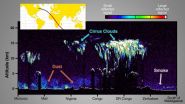"Developing a herpes vaccine is one of the holy grails of infectious disease research," said co-study leader William Jacobs Jr., Ph.D., a Howard Hughes Medical Institute Investigator and the Leo and Julia Forchheimer Chair in Microbiology & Immunology at Einstein. "We decided to take an approach that runs counter to most of the tactics used by other scientists--and we seem to have cracked the code." Dr. Jacobs is also professor of microbiology & immunology and of genetics at Einstein.
It was generally assumed that an effective HSV-2 vaccine must stimulate the body to produce neutralizing antibodies--particularly against a viral surface protein called glycoprotein D (gD-2) that HSV-2 uses to enter human cells. A protein that triggers antibody production is called an antigen. For decades, researchers have focused on "subunit" herpes vaccines that rely primarily on gD-2 as the antigen to stimulate the body's antibody response--but none has prevented HSV-2 infection in humans.
"This suggests we've been stimulating production of the wrong type of antibodies," said co-study leader Betsy Herold, M.D., the Harold and Muriel Block Chair in Pediatrics at Einstein and chief of the division of pediatric infectious diseases at The Children's Hospital at Montefiore and Einstein. Dr. Herold is also professor of pediatrics, of microbiology & immunology, and of obstetrics & gynecology and women's health at Einstein.
The Einstein team took a completely different approach in designing their "live" HSV-2 vaccine. Instead of using gD-2 to stimulate antibodies, they deleted the gene for gD-2 from the virus (and, consequently, the protein's expression on the viral surface) --a manipulation that weakens the virus, rendering it unable to infect cells or cause disease. They hypothesized that this altered virus would stimulate the body to produce different and more effective antibodies.
"We had a hunch that gD-2 might be masking other viral antigens, and that by removing this dominant protein we would expose those previously masked antigens to the immune system," said Dr. Jacobs.
When the vaccine, dubbed "delta-gD-2" ("delta" is shorthand for a gene deletion) was given to mice, it provided complete protection against subsequent infection with normal (wildtype) HSV-2, whether animals were challenged intravaginally or through the skin. No virus was detected in vaginal or skin tissue of vaccinated mice or in neural tissue, where HSV-2 often hides in a latent form only to emerge later to cause disease. When unvaccinated mice were challenged with wildtype HSV-2, all showed evidence of the virus in the three tissue sites, and all succumbed to the disease.
The vaccinated mice showed low levels of neutralizing antibodies but high levels of antibodies associated with a different immune response called antibody-dependent cell-mediated cytotoxicity (ADCC). This and other experiments described in the paper--such as finding that blood serum from vaccinated mice was able to passively protect unvaccinated mice --conclusively demonstrated that ADCC antibodies were responsible for protecting against HSV-2.
"Our findings challenge the existing dogma that says an effective herpes vaccine must stimulate neutralizing antibodies against gD-2," said Dr. Jacobs. "It's almost as if the virus evolved gD-2 specifically to hide the other antigens. gD-2 turns out to be a Trojan horse that misleads the immune system."
The new vaccine also appears to be safe. The researchers calculated the number of wildtype viruses needed to kill mice--and then administered 1,000 times that number of delta-g D-2 viruses to mice that lacked immune systems and so couldn't ward off infections. The result: The mice survived and didn't develop herpes. The Einstein team hopes to begin clinical trials on humans within a few years.
Initial tests suggest that the vaccine is also effective against HSV-1, or oral herpes, although this needs to be further evaluated. In addition, the vaccine's novel design may help in creating vaccines against other disease-causing microbes that invade the body through mucosal tissues, including HIV and the bacterium that causes tuberculosis.
"Genital herpes infections can not only be serious in and of themselves, but they also play a major role in fueling the HIV epidemic," said Dr. Herold. "People infected with HSV-2 are more likely to acquire and to transmit HIV--which further underscores the need to develop a safe and effective herpes vaccine."
Albert Einstein College of Medicine has filed patent applications related to this research and is seeking licensing partners able to further develop and commercialize this technology. Interested parties can contact the Office of Biotechnology at biotech@einstein.yu.edu.
The paper is titled "Herpes simplex type 2 virus deleted in glycoprotein D protects against vaginal, skin and neural disease." The other contributors are: Christopher Petro, Ph.D., Pablo A. González, Ph.D., Natalia Cheshenko, Ph.D., Thomas Jandl, Ph.D., Nazanin Khajoueinejad, Angèle Bénard, Ph.D., and Mayami Sengupta, Ph.D., all at Einstein.
The study was support by grants from the National Institute for Allergy and Infectious Diseases, part of the National Institutes of Health (AI065309, AI03461, AI084225 and AI063537) and the Howard Hughes Medical Institute.
The authors declare no financial conflict of interest.
About Herpes There are two types of herpes simplex virus: HSV-1 (more commonly associated with oral herpes) and HSV-2 (more commonly associated with genital herpes). Neither genital herpes nor oral herpes can be cured.
Oral herpes typically causes sores around the mouth and lips and is transmitted through oral secretions or skin sores. Oral herpes is a leading cause of corneal blindness worldwide.
Genital herpes, the focus of this study, is transmitted during sexual contact or at birth, from mother to child. In the U.S., about one out of every six people ages 14 to 49 years is infected with HSV-2, according to the Centers for Disease Control and Prevention. Genital herpes is more common in urban areas, such as New York City, and in developing countries, especially in Sub-Saharan Africa.
Most people with genital herpes are symptom-free but periodically shed the virus, which they may unknowingly transmit to their partner or newborn. Genital herpes sores typically appear as one or more blisters on or around the genitals, rectum, or mouth. The blisters break and leave painful sores that may take weeks to heal. The first of these "outbreaks" may be accompanied by flu-like symptoms. Repeat outbreaks are common, especially the first year after infection. Although genital herpes infection can persist for life, the number of outbreaks tends to decrease over time. Drugs can relieve symptoms and reduce the number and duration of outbreaks.
INFORMATION:
About Albert Einstein College of Medicine of Yeshiva University
Albert Einstein College of Medicine of Yeshiva University is one of the nation's premier centers for research, medical education and clinical investigation. During the 2013-2014 academic year, Einstein is home to 743 M.D. students, 275 Ph.D. students, 103 students in the combined M.D./Ph.D. program, and 313 postdoctoral research fellows. The College of Medicine has more than 2,000 full-time faculty members located on the main campus and at its clinical affiliates. In 2013, Einstein received more than $150 million in awards from the National Institutes of Health (NIH). This includes the funding of major research centers at Einstein in aging, intellectual development disorders, diabetes, cancer, clinical and translational research, liver disease, and AIDS. Other areas where the College of Medicine is concentrating its efforts include developmental brain research, neuroscience, cardiac disease, and initiatives to reduce and eliminate ethnic and racial health disparities. Its partnership with Montefiore Medical Center, the University Hospital and academic medical center for Einstein, advances clinical and translational research to accelerate the pace at which new discoveries become the treatments and therapies that benefit patients. Through its extensive affiliation network involving Montefiore, Jacobi Medical Center -- Einstein's founding hospital, and three other hospital systems in the Bronx, Brooklyn and on Long Island, Einstein runs one of the largest residency and fellowship training programs in the medical and dental professions in the United States. For more information, please visit www.einstein.yu.edu, read our blog, follow us on Twitter, like us on Facebook, and view us on YouTube.

